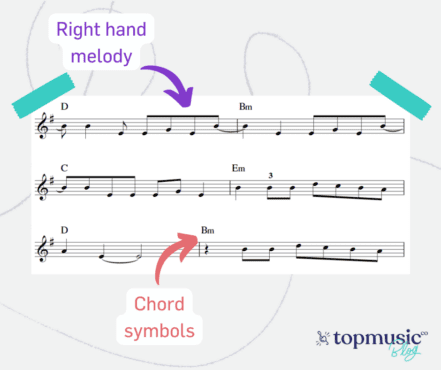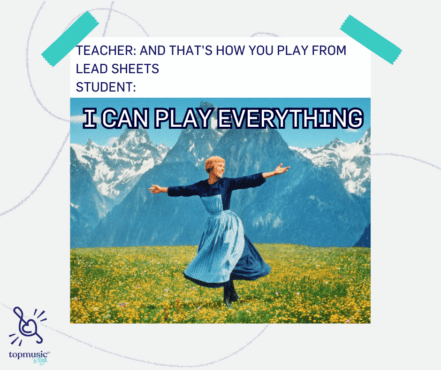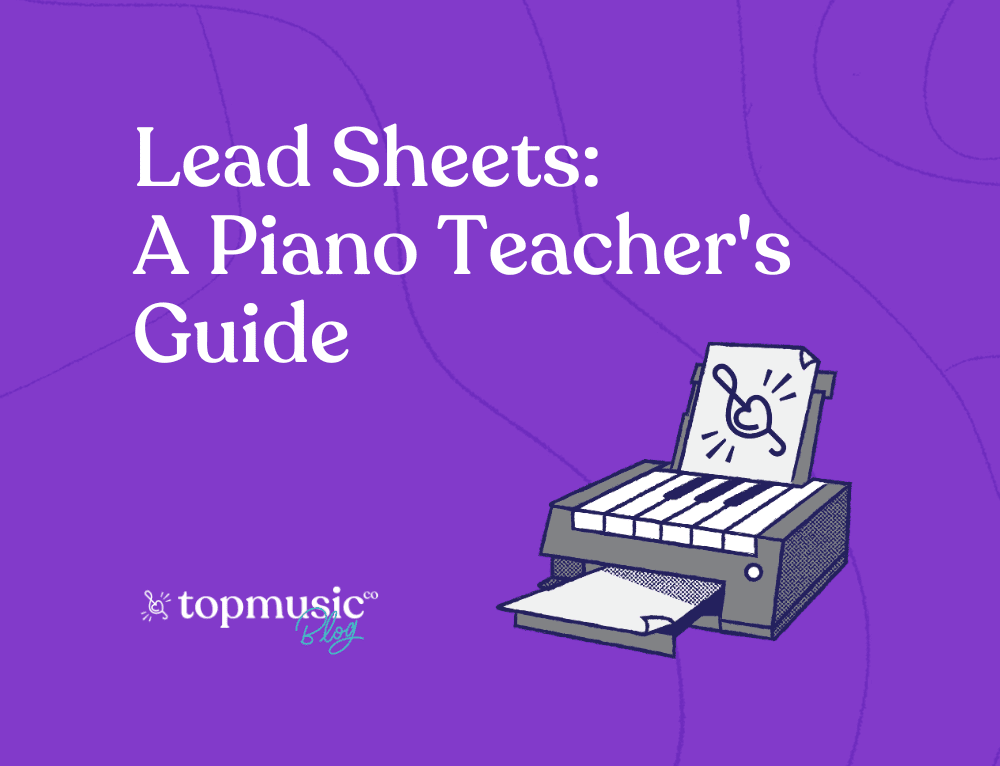Lead sheets open up a whole new world of music for our students. But if they’re not in your piano teacher toolkit it can be tricky knowing where to start. Let us help you!
Lead sheets. These words fill some teachers will joy, and others with dread. And some think, “Lead what?!”
With more and more piano teachers straying away from the more ‘traditional’ ways of teaching and replacing exams with more creative ways of learning, lead sheets are in high demand.
But what are they and how do you teach them? We’ve got you covered!
Table Of Contents:
Think about a piece of sheet music. Typically, have your right-hand melody and your left-hand accompaniment.
Remove that left-hand accompaniment, keep the right-hand melody, and add chord symbols. You now have your lead sheet. If it’s a lead sheet of a pop song you might even find lyrics.

If you were to remove the melody line and keep the lyrics and the chord symbols you would have a chord chart. These simply focus on the accompaniment, leaving the melody line to a singer or another instrumentalist.
For a deeper dive into the differences between chord charts and lead sheets, click here.
But why do we use lead sheets? Well, they have many benefits, including
For even more benefits of teaching your students lead sheets (and an explanation as to what an ‘all-rounder’ pianist is!), check out this blog.
Ooh, and this one too! (Can you tell we really like teaching lead sheets?)
“I don’t think lead sheets are for me. I prefer a more traditional approach to music.” We hear that, and we respect that completely! We’ll just leave this blog, How Bach Would Teach Piano Lead Sheets here in case you want to have a read!
Great question! And, hopefully, we have some great answers!
The first step is to make sure they have a good understanding of chords. Let us help you with that:
The next step is to find some good lead sheets. You can find some great ones on musicnotes.com. You can either do a general search for ‘lead sheets’ or search for a song and select ‘lead sheet’ in the scoring options. (Psst, did you know that you can get 20% off sheet music at musicnotes.com with a TopMusicPro membership?)
Work on the melody line first.
When the student is confident with their right hand, start introducing the left-hand chords. You can begin with simple block chords, and then encourage them to become more adventurous. If they’re lacking inspiration for left-hand patterns, we recommend showing them The Ultimate Guide To Left Hand Patterns.
Like with most things, the more you practice the more confident you get! (And you can boost your confidence by listening to this great podcast episode)
And the more confident you get, you could even start creating your own lead sheets!

Our short answer is: yes!
Our long answer? Yeeeeeeeeeeessssssss!
Just kidding. We have a more in-depth longer answer!
Reasons Why You Should Teach Students To Play By Ear:
Did you know… That we have a brand new series called Pop Song Solutions where Tim takes a requested song and demonstrates how to teach it to your students by ear?
This is a member-exclusive perk, but you can find some videos over on our YouTube!
We know that teaching to play by ear feels like a step into the unknown, but a scary step can lead to a satisfying outcome.
“Sounds good, but I definitely need more help with this!” We hear you! Which is why we spoke to Ruth Power, playing-by-ear expert!
We also wanted to tell you how you (yes, you!) can simplify a pop song and teach your students to play it by ear!
Absolutely!
As the process of playing by ear is listening to a song and figuring out how to play (in a nutshell!) then any ear training will definitely help!
Ear training can be done in many different ways:
GREAT question! And we definitely have a great answer!
We have a fantastic course, “Taking The Lead with Forrest Kinney,” which guides you through teaching your students how to play from lead sheets and create their own amazing arrangement of Happy Birthday (that they will be proud to play at parties!)

This course is available as a one-off purchase at $149 here.
It’s also available to Studio and Evolution members of TopMusicPro.
